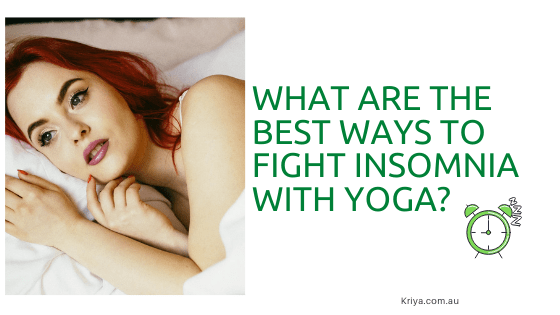
What Are The Best Ways To Fight Insomnia With Yoga?
I am not able to sleep at night these days. Tossing over the bed, waking up and staring at the bedroom or simply walking around the house in the middle of the night became my routine. Sleep deprivation is a problem, which can be either a physical or mental disorder that if not taken care of can lead to many other hard-core diseases of the body.
Insomnia as it is called in medical terms was far away from me a few months back. Until recently the loss of someone dear to me became the cause of staying awake at night. Thanks to one of my yoga friends who guided me to do yoga for a good night’s sleep. I have started practising yoga for Insomnia recently and believe me in two days of doing this, I feel better going to bed and tossing and turning at night.
Causes of Insomnia
Insomnia is caused by following factors:
- Stress and anxiety
- Continuous travelling and Jet Lag
- Certain Medications
- Depression
- High Blood Pressure
- Asthma attack at night
- Drinking too much coffee or tea
- Lack of physical exercise
- Old Age
- Watching movies or TV at night
- Using Mobile at Night
- Your room temperature and environment
And many other factors
Types of Insomnia
There are two basic types of Insomnia
- Primary Insomnia: This means your sleep problems aren’t linked to any other health condition or problem.
- Secondary Insomnia: You have some health issues that don’t allow you to sleep which can be pain, cancer, medications, alcohol, Asthma, depression or any other mental disorder.
Remember that insomnia can be acute or chronic and also may vary between the two. Acute insomnia lasts from 1 night to a few weeks. Insomnia is chronic when it happens at least 3 nights a week for 3 months or more.
Insomnia can be treated with allopathy, homeopath, Ayurvedic, Naturopathy and by doing Yoga.
I prefer the yoga for Insomnia way to treat my sleep disorder as its is primary insomnia and will go away soon.
In US according to various sleep surveys and studies showed that nearly 70 million Americans have a sleep disorder. Insomnia is the most common sleep disorder, with 30% of adults experiencing short-term insomnia About 10% of people have long-lasting insomnia. Almost 40% of people report accidentally falling asleep during the day and about 5% report falling asleep while driving. More than 50% of pregnant women experience sleep issues that may be insomnia symptoms, as well.
In Australia, almost 90% of Australians suffer from a sleeping disorder, with 30% experiencing a severe sleeping disorder. 5% of the Australian population experience chronic insomnia. Of these, approximately 75% are due to underlying medical or psychological conditions that are secondary insomnia. The remaining 25% are cases of primary insomnia.
What Are The Best Ways To Fight Insomnia With Yoga?
There are many yoga for Insomnia, yoga asanas that help you relieve primary insomnia. Doing Yoga will soothe your mind and body before bed and you will catch some well-deserved sleep. Here are the four yoga poses that will help you fight primary insomnia with yoga.
1. Head to Knee Pose or Janu Sirsasana
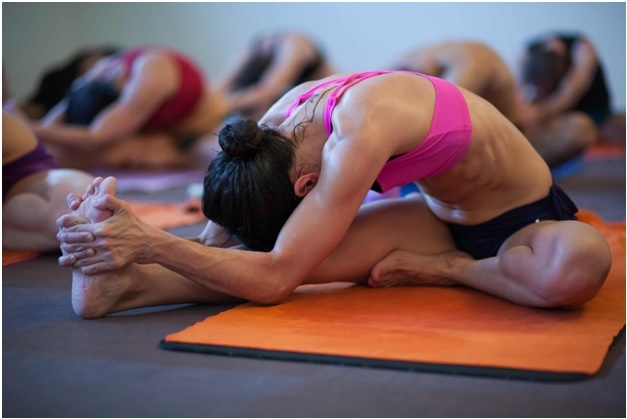
To do this yoga for Insomnia sit on the floor, legs extended straight in front of you and knees bent if necessary to keep the spine from rounding.
• Bend the right knee and open the hip, bringing the sole of the right foot into the inner left thigh and the right knee toward the ground. If it doesn’t reach, support the right knee with a cushion or bolster.
• Inhale and lengthen the spine.
• Exhale as you bend forward from the hips over the left leg, keeping the spine and neck long, and place the hands on either side of the left leg. Gaze at the big toe of the left foot as you focus on the breath moving in and out.
• Repeat on the other side.
Those with tight hamstrings will find all forward bends easier with a folded blanket or cushion under the sitting bones.
2. Bound Angle Pose or Baddha Konasana
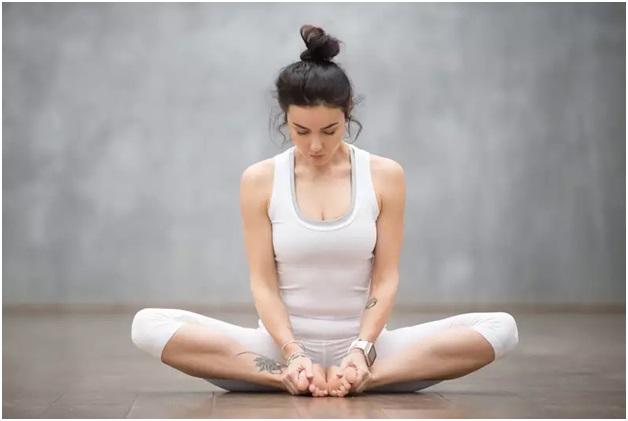
For this yoga for Insomnia pose sit on the floor and bring the soles of the feet together in front of you, hands holding the feet or ankles. If you’re comfortable and able to sit without rounding the lower back, bring the feet as close as you can toward the groin.
• Now Inhale and lengthen the spine.
• Next Exhale and bend forward from the hips, keeping the spine long. Breathe in and out as you feel your muscles relaxing.
If sitting in this pose is not comfortable for you, you may skip the forward bend. Sitting on a blanket or cushion can help tight bodies open up.
3. Wide Angle forward bend or Upavistha Konasana
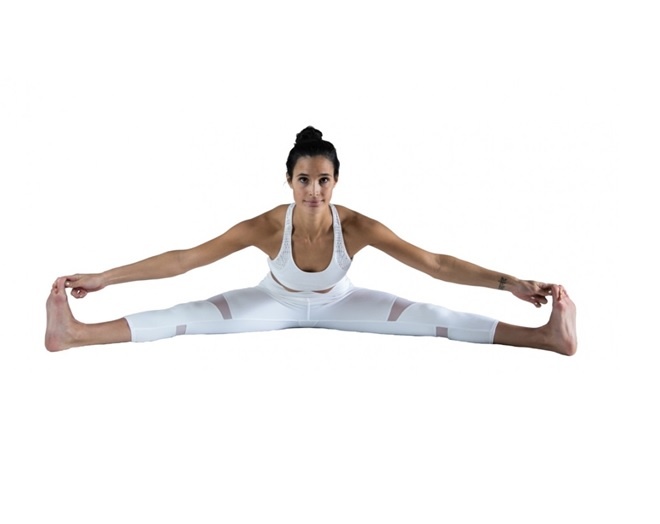
For this yoga for insomnia, asana sit upright on the floor, and extend the legs in front of you in a V shape, placing hands behind the buttocks for balance. Be comfortable and stretch the width accordingly.
Now inhale and lengthen the spine, ensuring the lower back isn’t rounding.
Next exhale and bend forward from the hips, with hands in front of you. Focus on the breath as you lengthen the spine with every inhale and relax forward with every exhale.
Again as said above if sitting in this pose is uncomfortable for you, you may skip the forward bend and keep the hands behind the buttocks; focus on sitting up without rounding the back. Try sitting on a cushion or folded blanket, or bending the knees and placing support under them.
4. Thread-the-needle or Urdhva Mukha Pasasana
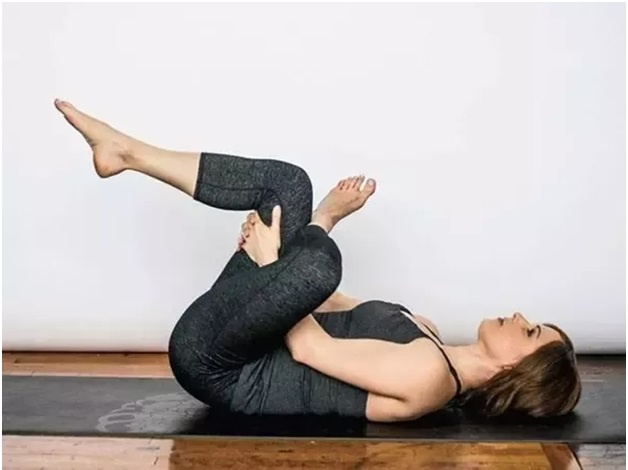
In doing this yoga for insomnia pose you need to lie on your back with the head flat on the floor. Bend the knees and place the soles of the feet on the floor.
- Now bring the right knee toward the chest. Keeping the hips even, place the right ankle below the left knee with the right knee pointing to the right. Flex the right foot to keep the muscles engaged and protect the knee from strain.
- Next, lift the left foot off the floor and bring the left knee toward the chest. Bring the hands on either side of the left thigh for support.
- You should feel a stretch on the outside of the right hip. As you breathe in and out, try to bring both hips parallel.
- Similarly, repeat on the other side.
Remember be comfortable with your body and only go as deep as you need to feel a gentle stretch.
All the above yoga poses you can do in the sequence for one to five minutes. It’s your choice to do the poses on the floor or on your bed. Never stress or stretch too much for these asanas. Go slow and increase the time if you feel comfortable.
You can also talk with your yoga teacher for more of such yoga poses to help you go to sleep faster.
Tips To A Good Night Sleep
Here are few of the tips you can use to fall into a good night sleep.
- Avoid taking naps during the day
- Limit tea, coffee or alcohol
- Eat at least one bowl of fruit and green vegetables in day time
- Take dinner or meals 3 hours before your bed time
- Go for a lukewarm shower at night
- Soak your feet in warm water for 15 mins before bed
- Avoid heavy meals at night
- Switch off TV and Mobile two hours before bed and shut down all electronic screen gadgets
- Maintain the room temperature to fall sleep. Your body’s temperature decreases during sleep, and a cool, but not cold, room will help you settle into and maintain sleep throughout the night. A room temperature of around 65°F (18.3°C) is optimal for good nighttime sleep.
- Bedroom should be calm and quiet
- Mattress and pillows should be comfortable
- You can use eye masks or eye blinders if you want.
Last but not least before you sleep do at least 5 minutes of meditation. Say your prayers and thank God for the day that has passed. Thank each and everyone in your life for making your day a happier one before you say goodnight.
